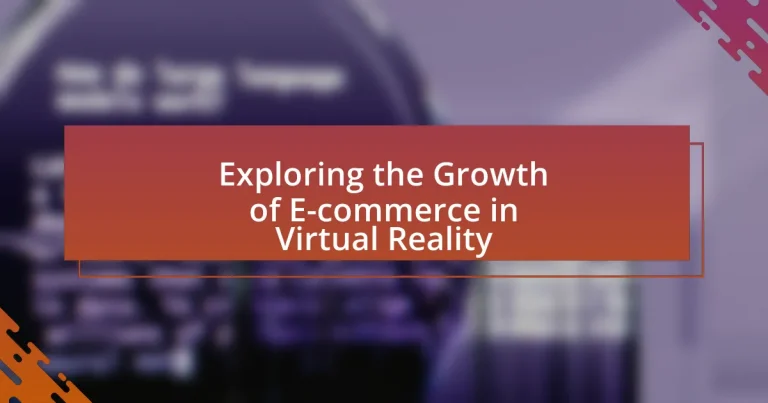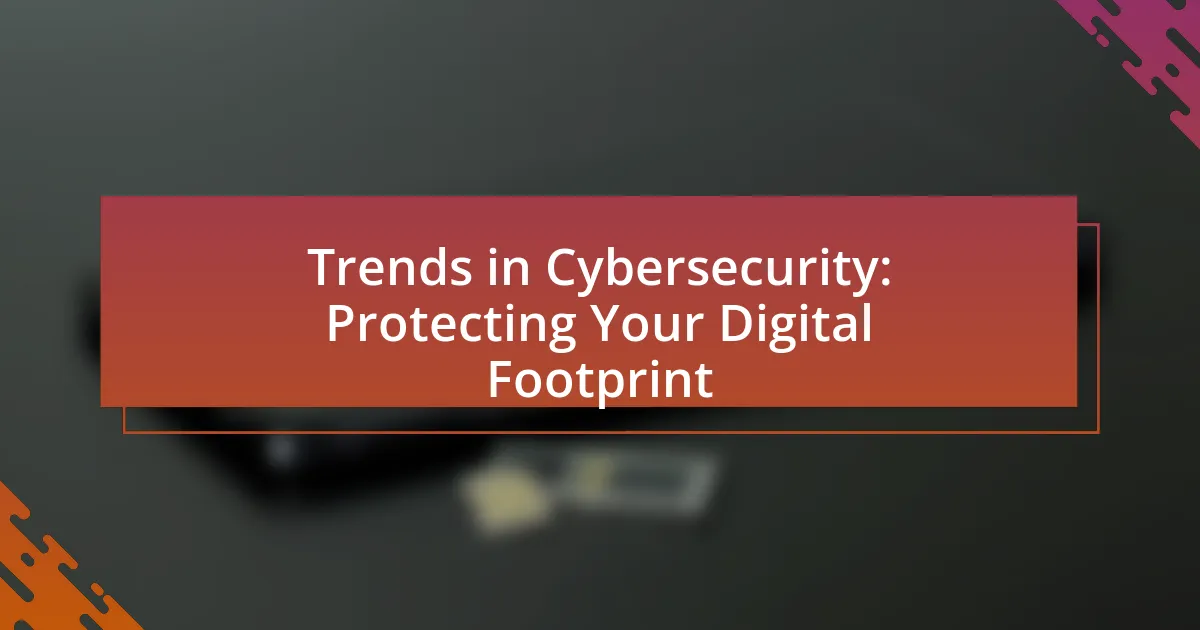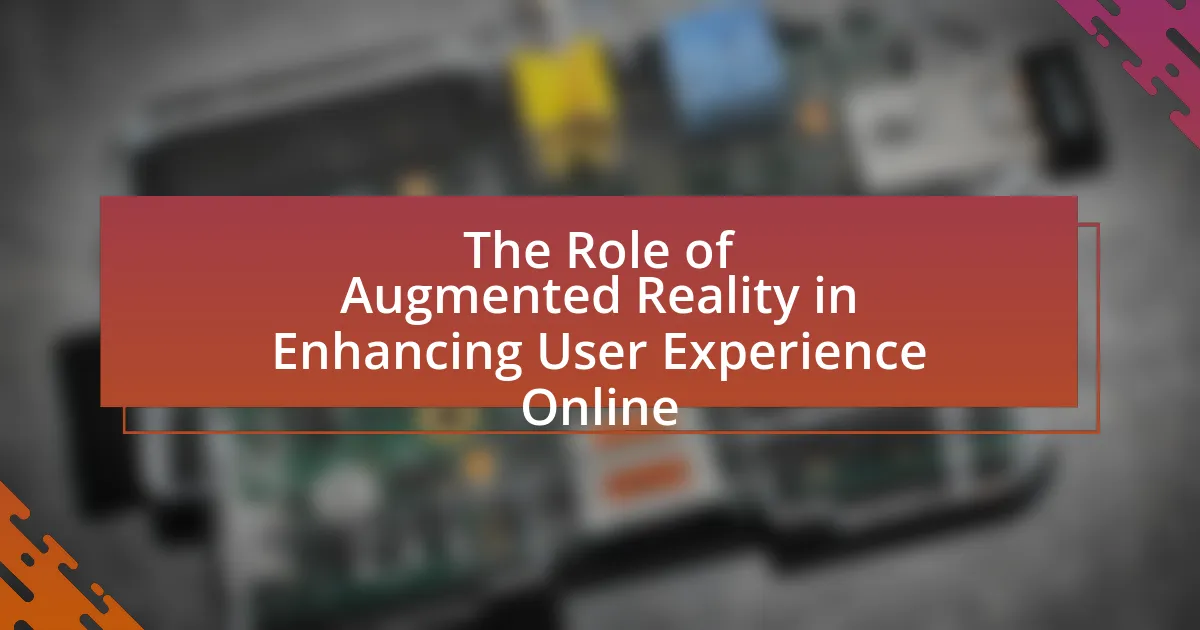E-commerce in Virtual Reality (VR) represents a transformative approach to online shopping, allowing consumers to engage with products in a three-dimensional environment. This article explores the differences between VR e-commerce and traditional platforms, highlighting the immersive experiences that enhance customer engagement and satisfaction. Key technologies enabling this shift include VR headsets, 3D modeling, and blockchain for secure transactions. The article also examines consumer trends driving growth, the benefits for businesses, and the challenges faced in implementing VR e-commerce, such as high development costs and security concerns. Additionally, it discusses future trends, including personalization and social commerce, which are expected to shape the evolution of e-commerce in VR.
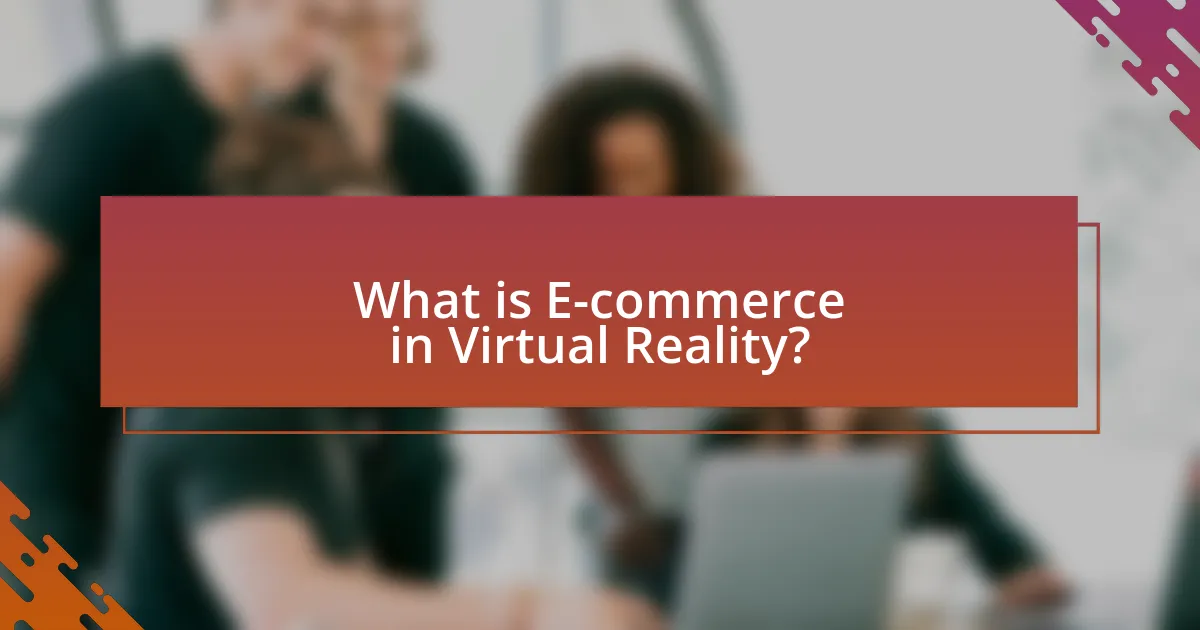
What is E-commerce in Virtual Reality?
E-commerce in Virtual Reality refers to the buying and selling of goods and services within a virtual environment, allowing users to interact with products in a three-dimensional space. This innovative approach enhances the shopping experience by enabling customers to visualize and manipulate products as if they were physically present, leading to more informed purchasing decisions. According to a report by Statista, the global virtual reality market is projected to reach $57.55 billion by 2027, indicating significant growth potential for e-commerce platforms that integrate VR technology.
How does E-commerce in Virtual Reality differ from traditional e-commerce?
E-commerce in Virtual Reality differs from traditional e-commerce primarily through its immersive shopping experience. In virtual reality, consumers can interact with products in a 3D environment, allowing them to visualize and manipulate items as if they were physically present, which enhances engagement and decision-making. Traditional e-commerce, on the other hand, relies on 2D images and descriptions, limiting the sensory experience. Research indicates that immersive experiences can increase consumer confidence and satisfaction, as evidenced by a study from the Journal of Retailing and Consumer Services, which found that VR shopping can lead to higher purchase intentions compared to conventional online shopping methods.
What technologies enable E-commerce in Virtual Reality?
E-commerce in Virtual Reality is enabled by technologies such as virtual reality headsets, 3D modeling software, augmented reality integration, and blockchain for secure transactions. Virtual reality headsets, like the Oculus Rift and HTC Vive, provide immersive shopping experiences, allowing users to navigate virtual stores as if they were physically present. 3D modeling software enables the creation of realistic product representations, enhancing user engagement and decision-making. Augmented reality integration allows users to visualize products in their real-world environment before purchase, increasing confidence in buying decisions. Blockchain technology ensures secure and transparent transactions, fostering trust in e-commerce platforms. These technologies collectively enhance the user experience and operational efficiency in virtual reality e-commerce.
How do user experiences vary between E-commerce in Virtual Reality and traditional platforms?
User experiences in E-commerce differ significantly between Virtual Reality (VR) and traditional platforms, primarily due to the immersive nature of VR. In VR, users engage in a three-dimensional environment that allows for interactive product exploration, enhancing sensory engagement and emotional connection, which is often lacking in traditional two-dimensional interfaces. Research indicates that VR can increase user satisfaction and purchase intent by up to 30% compared to traditional online shopping experiences, as users can visualize products in a more realistic context. Additionally, VR facilitates social interactions, allowing users to shop together in virtual spaces, which traditional platforms do not offer. This immersive and interactive experience in VR leads to a more engaging and memorable shopping journey, contrasting with the more transactional and less engaging nature of traditional E-commerce platforms.
Why is E-commerce in Virtual Reality gaining popularity?
E-commerce in Virtual Reality is gaining popularity due to its ability to create immersive shopping experiences that enhance customer engagement and satisfaction. This technology allows consumers to interact with products in a 3D environment, simulating a physical store experience from the comfort of their homes. According to a report by Statista, the global virtual reality market is projected to reach $57.55 billion by 2027, indicating a significant interest in VR applications, including e-commerce. Additionally, studies show that immersive experiences can increase conversion rates by up to 30%, demonstrating the effectiveness of VR in driving sales.
What consumer trends are driving the growth of E-commerce in Virtual Reality?
Consumer trends driving the growth of E-commerce in Virtual Reality include increased demand for immersive shopping experiences, personalization, and social interaction. Immersive shopping experiences allow consumers to visualize products in 3D, enhancing decision-making; for instance, a study by PwC found that 79% of consumers prefer to shop in immersive environments. Personalization trends, such as tailored recommendations based on user behavior, further engage consumers, with 80% of shoppers indicating they are more likely to purchase from brands that offer personalized experiences. Additionally, social interaction within virtual environments fosters community and engagement, as evidenced by the rise of social VR platforms where users can shop together, leading to higher conversion rates. These trends collectively contribute to the expanding landscape of E-commerce in Virtual Reality.
How do immersive experiences enhance customer engagement in E-commerce?
Immersive experiences enhance customer engagement in E-commerce by creating interactive and realistic environments that allow customers to visualize products in a more meaningful way. For instance, virtual reality (VR) and augmented reality (AR) technologies enable shoppers to try on clothes or visualize furniture in their homes, leading to increased satisfaction and reduced return rates. According to a study by the Harvard Business Review, immersive experiences can increase customer engagement by up to 30%, as they foster a deeper emotional connection with the brand and products. This heightened engagement translates into longer browsing times and higher conversion rates, demonstrating the effectiveness of immersive technologies in enhancing the E-commerce shopping experience.
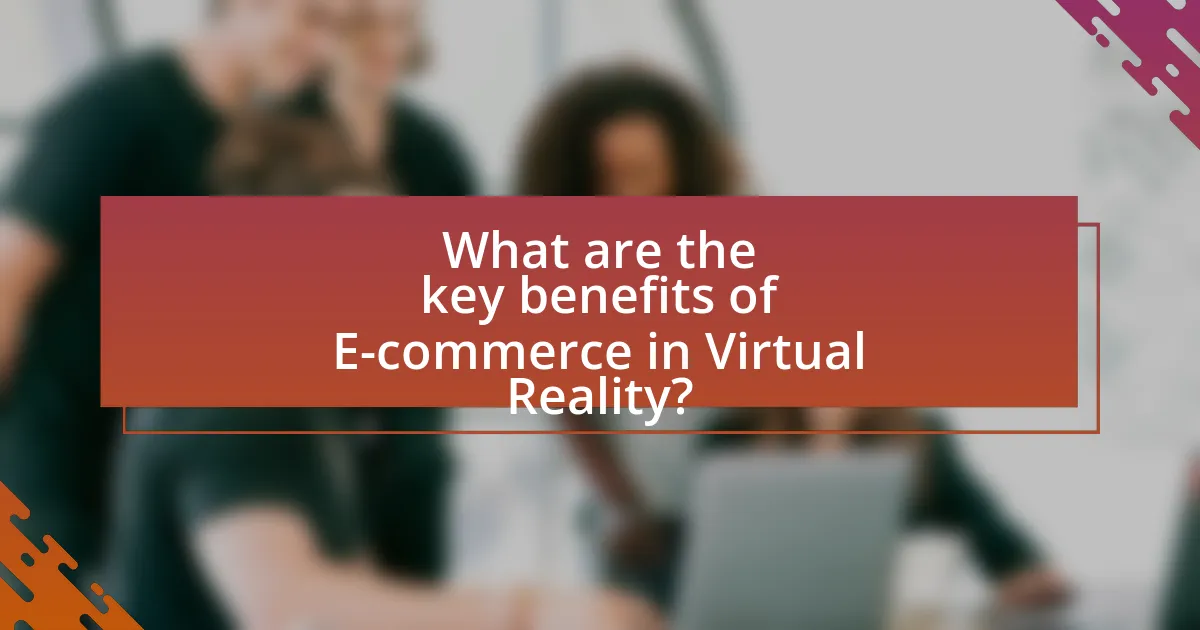
What are the key benefits of E-commerce in Virtual Reality?
The key benefits of E-commerce in Virtual Reality include enhanced customer engagement, immersive shopping experiences, and increased conversion rates. Enhanced customer engagement occurs as VR allows users to interact with products in a 3D environment, making the shopping experience more engaging compared to traditional online shopping. Immersive shopping experiences enable customers to visualize products in their own space, leading to better-informed purchasing decisions. Studies indicate that VR can increase conversion rates by up to 30%, as customers feel more confident in their purchases when they can interact with products virtually.
How does E-commerce in Virtual Reality improve customer satisfaction?
E-commerce in Virtual Reality improves customer satisfaction by providing immersive shopping experiences that enhance engagement and personalization. Virtual Reality allows customers to interact with products in a 3D environment, enabling them to visualize items more realistically compared to traditional online shopping. This immersive experience can lead to higher confidence in purchasing decisions, as studies indicate that 70% of consumers feel more satisfied when they can interact with products virtually before buying. Additionally, Virtual Reality can offer personalized recommendations based on user behavior and preferences, further increasing satisfaction levels.
What role does personalization play in E-commerce in Virtual Reality?
Personalization plays a crucial role in E-commerce in Virtual Reality by enhancing user engagement and improving the shopping experience. In virtual environments, personalized recommendations based on user behavior and preferences can lead to higher conversion rates, as studies indicate that personalized shopping experiences can increase sales by up to 20%. Additionally, virtual reality allows for tailored interactions, such as customized avatars and personalized store layouts, which create a more immersive and relevant shopping experience for consumers. This level of personalization not only fosters customer loyalty but also encourages repeat purchases, as users are more likely to return to a platform that understands and caters to their individual needs.
How can E-commerce in Virtual Reality reduce return rates?
E-commerce in Virtual Reality can reduce return rates by providing customers with immersive experiences that enhance product visualization and interaction. This technology allows consumers to virtually try on clothing, visualize furniture in their own space, or interact with products in a 3D environment, leading to more informed purchasing decisions. Research indicates that immersive experiences can increase customer confidence in their choices, thereby decreasing the likelihood of returns. For instance, a study by the University of Southern California found that virtual try-ons can reduce return rates by up to 30% compared to traditional online shopping methods.
What advantages do businesses gain from adopting E-commerce in Virtual Reality?
Businesses gain several advantages from adopting E-commerce in Virtual Reality, including enhanced customer engagement, improved product visualization, and increased sales conversion rates. Enhanced customer engagement occurs as virtual reality allows consumers to interact with products in a more immersive environment, leading to a deeper emotional connection. Improved product visualization enables customers to experience products in 3D, which can reduce uncertainty and increase confidence in purchasing decisions. Additionally, studies have shown that businesses utilizing virtual reality in their e-commerce strategies can see sales conversion rates increase by up to 30%, demonstrating the effectiveness of this technology in driving revenue.
How can businesses leverage data analytics in E-commerce in Virtual Reality?
Businesses can leverage data analytics in E-commerce in Virtual Reality by analyzing user behavior and preferences to enhance the shopping experience. By utilizing data analytics tools, companies can track metrics such as time spent in virtual environments, product interactions, and purchase patterns. For instance, a study by PwC found that 82% of retailers believe that data analytics significantly improves customer experience. This data allows businesses to personalize offerings, optimize inventory management, and create targeted marketing strategies, ultimately leading to increased sales and customer satisfaction.
What cost savings can be achieved through E-commerce in Virtual Reality?
E-commerce in Virtual Reality can achieve significant cost savings through reduced operational expenses, enhanced customer engagement, and minimized return rates. By utilizing virtual storefronts, businesses can lower costs associated with physical retail spaces, such as rent and utilities, while also decreasing inventory costs through virtual try-ons that allow customers to visualize products before purchase. Research indicates that companies employing VR for e-commerce report up to a 30% reduction in return rates, as customers make more informed purchasing decisions. Additionally, immersive experiences can lead to higher conversion rates, further optimizing marketing expenditures.
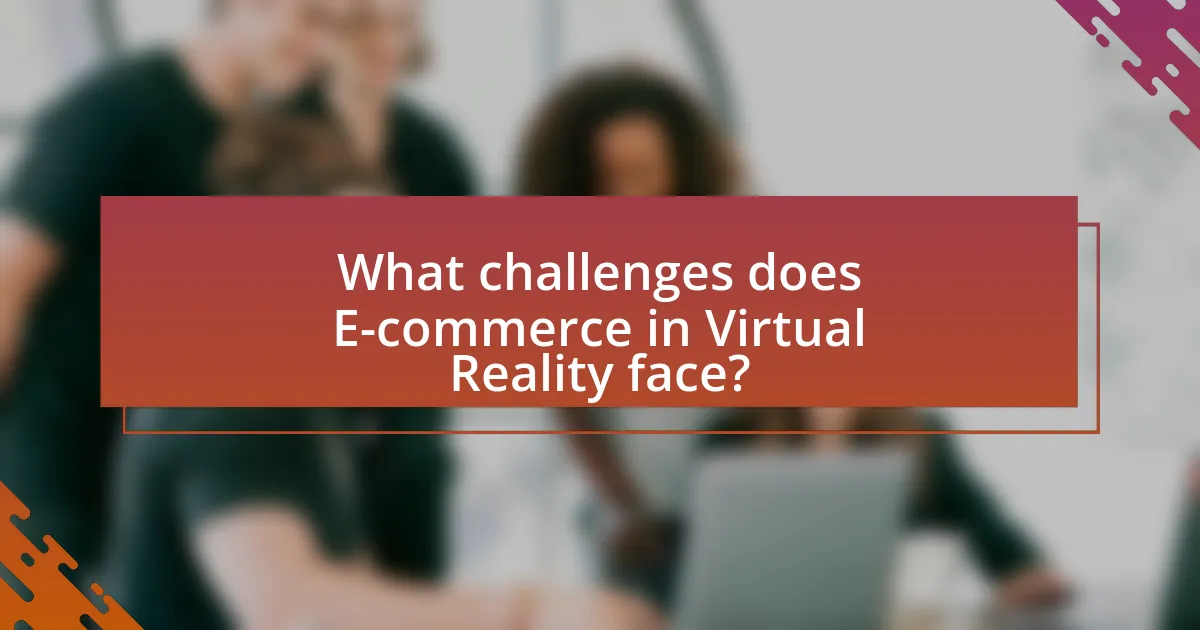
What challenges does E-commerce in Virtual Reality face?
E-commerce in Virtual Reality faces several challenges, including high development costs, limited consumer adoption, and technological barriers. High development costs arise from the need for advanced hardware and software to create immersive experiences, which can deter businesses from investing. Limited consumer adoption is evident as many users lack access to VR devices or are unfamiliar with the technology, resulting in a smaller market base. Technological barriers include issues related to internet bandwidth and the need for seamless integration with existing e-commerce platforms, which can complicate the user experience. These challenges hinder the widespread implementation and growth of e-commerce in the virtual reality space.
What are the technological barriers to implementing E-commerce in Virtual Reality?
The technological barriers to implementing E-commerce in Virtual Reality include limited hardware capabilities, high development costs, and inadequate user interface design. Limited hardware capabilities hinder the performance of VR systems, as many consumers do not possess the necessary devices, such as high-end VR headsets or powerful computers, which restricts market reach. High development costs arise from the need for specialized skills and resources to create immersive VR environments, making it financially challenging for small businesses to enter the market. Inadequate user interface design can lead to poor user experiences, as existing interfaces may not translate well into a 3D space, resulting in confusion and frustration for users. These barriers collectively impede the widespread adoption of E-commerce in Virtual Reality.
How can businesses overcome the high costs associated with E-commerce in Virtual Reality?
Businesses can overcome the high costs associated with E-commerce in Virtual Reality by leveraging cost-effective technologies and optimizing their operational strategies. Implementing cloud-based VR solutions can significantly reduce the need for expensive hardware, as these platforms often provide scalable resources that adapt to business needs. Additionally, utilizing open-source VR development tools can lower software development costs while still allowing for customization and innovation.
Furthermore, businesses can focus on targeted marketing strategies to maximize ROI, such as using data analytics to identify customer preferences and behaviors, which can lead to more efficient advertising spend. Collaborating with VR content creators and influencers can also enhance brand visibility without incurring high costs.
According to a report by Statista, the global VR market is projected to reach $57.55 billion by 2027, indicating a growing acceptance and potential for cost-effective solutions in this space. By adopting these strategies, businesses can effectively manage and reduce the financial burdens associated with E-commerce in Virtual Reality.
What security concerns exist in E-commerce in Virtual Reality?
Security concerns in E-commerce in Virtual Reality include data privacy, payment security, and identity theft. Data privacy is compromised as users share personal information in immersive environments, increasing the risk of unauthorized access. Payment security is a significant issue, as virtual transactions may be susceptible to fraud and hacking, with a report from Cybersecurity Ventures predicting that global cybercrime costs will reach $10.5 trillion annually by 2025. Identity theft is also prevalent, as attackers can exploit VR platforms to impersonate users, leading to financial loss and reputational damage. These concerns highlight the need for robust security measures in the evolving landscape of virtual reality commerce.
How do consumer perceptions impact the growth of E-commerce in Virtual Reality?
Consumer perceptions significantly impact the growth of E-commerce in Virtual Reality by influencing their willingness to engage with and invest in VR shopping experiences. Positive perceptions, such as the immersive nature of VR and the enhanced shopping experience it offers, can lead to increased consumer interest and spending. For instance, a study by PwC found that 79% of consumers prefer to shop in immersive environments, indicating that favorable perceptions can drive higher engagement levels. Conversely, negative perceptions, such as concerns about technology complexity or privacy issues, can hinder adoption and limit market growth. Therefore, addressing consumer perceptions through effective marketing and user experience design is crucial for the expansion of E-commerce in Virtual Reality.
What misconceptions do consumers have about E-commerce in Virtual Reality?
Consumers often mistakenly believe that E-commerce in Virtual Reality is solely about immersive shopping experiences without recognizing its broader implications, such as enhanced product visualization and social interaction. This misconception overlooks the fact that VR E-commerce can provide detailed 3D representations of products, allowing consumers to examine items from multiple angles, which traditional online shopping cannot offer. Additionally, studies indicate that VR can facilitate social shopping experiences, enabling users to shop together in a virtual space, thereby enhancing engagement and satisfaction.
How can businesses address consumer hesitations regarding E-commerce in Virtual Reality?
Businesses can address consumer hesitations regarding E-commerce in Virtual Reality by enhancing user experience through immersive technology and providing robust security measures. By utilizing high-quality graphics and intuitive interfaces, businesses can create engaging virtual environments that mimic real-world shopping experiences, which can increase consumer confidence. Additionally, implementing secure payment systems and transparent data protection policies can alleviate concerns about privacy and fraud. Research indicates that 70% of consumers are more likely to shop online if they feel their data is secure, highlighting the importance of trust in E-commerce.
What are the future trends in E-commerce in Virtual Reality?
Future trends in e-commerce in virtual reality include enhanced immersive shopping experiences, increased personalization through AI integration, and the rise of social commerce within virtual environments. Immersive shopping experiences allow consumers to interact with products in a 3D space, leading to higher engagement and conversion rates; for instance, a study by PwC found that 82% of consumers prefer immersive experiences over traditional shopping. Personalization will be driven by AI algorithms analyzing user behavior to tailor product recommendations, improving customer satisfaction and loyalty. Additionally, social commerce will leverage virtual reality platforms to create shared shopping experiences, enabling users to shop together in real-time, which aligns with the growing trend of social interaction in online shopping.
How will advancements in technology shape the future of E-commerce in Virtual Reality?
Advancements in technology will significantly shape the future of E-commerce in Virtual Reality by enhancing user experience and streamlining transactions. Technologies such as augmented reality (AR), artificial intelligence (AI), and blockchain are expected to create immersive shopping environments, allowing consumers to interact with products in a virtual space. For instance, AR can enable customers to visualize products in their own homes before making a purchase, increasing confidence in buying decisions. Additionally, AI can personalize shopping experiences by analyzing user behavior and preferences, leading to tailored recommendations. Blockchain technology can enhance security and transparency in transactions, fostering trust between consumers and retailers. According to a report by Statista, the global virtual reality market is projected to reach $57.55 billion by 2027, indicating a growing integration of VR in various sectors, including E-commerce.
What role will social commerce play in the evolution of E-commerce in Virtual Reality?
Social commerce will significantly enhance the evolution of E-commerce in Virtual Reality by facilitating interactive shopping experiences that blend social engagement with online purchasing. This integration allows users to shop collaboratively in virtual environments, where they can share opinions, make recommendations, and influence each other’s buying decisions in real-time. Research indicates that 54% of consumers are more likely to purchase a product after seeing it on social media, highlighting the effectiveness of social influence in driving sales. As Virtual Reality platforms continue to develop, the incorporation of social commerce features will likely lead to increased consumer engagement and higher conversion rates, ultimately transforming how people shop online.
What best practices should businesses follow when implementing E-commerce in Virtual Reality?
Businesses should prioritize user experience, seamless navigation, and immersive content when implementing E-commerce in Virtual Reality. Focusing on user experience ensures that customers can easily interact with products in a virtual environment, which enhances engagement and satisfaction. Seamless navigation allows users to move through the virtual space without confusion, thereby reducing frustration and increasing the likelihood of purchases. Immersive content, such as 3D product displays and interactive features, can significantly boost customer interest and retention. According to a study by PwC, 82% of retailers believe that VR will enhance the shopping experience, indicating a strong correlation between effective VR implementation and consumer engagement.
How can businesses effectively market their E-commerce in Virtual Reality platforms?
Businesses can effectively market their E-commerce in Virtual Reality platforms by creating immersive shopping experiences that engage customers. This can be achieved through virtual storefronts that allow users to browse products in a 3D environment, enhancing the visual appeal and interactivity of the shopping process. For instance, a study by PwC found that 82% of consumers prefer to shop in immersive environments, indicating a strong consumer interest in VR shopping experiences. Additionally, businesses can utilize VR to offer personalized recommendations based on user behavior and preferences, further increasing engagement and conversion rates. By leveraging these strategies, companies can tap into the growing trend of E-commerce in Virtual Reality, driving sales and customer loyalty.
What strategies can enhance user experience in E-commerce in Virtual Reality?
To enhance user experience in E-commerce in Virtual Reality, implementing immersive product visualization is crucial. This strategy allows users to interact with products in a 3D space, providing a realistic sense of scale and detail that traditional online shopping cannot offer. Research indicates that 61% of consumers prefer shopping in VR due to its engaging nature, which significantly increases purchase intent. Additionally, incorporating social interaction features, such as virtual shopping with friends, can create a more enjoyable and collaborative experience, further driving engagement and sales.
